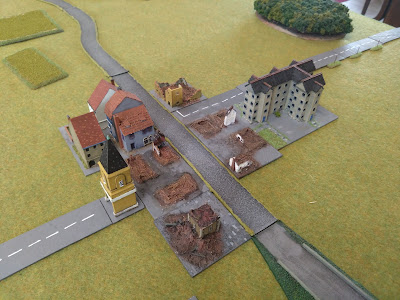On Friday 5th April I headed over the Peak District to the wonderfully picturesque village of Dungworth situated near Sheffield for Crisis Point 2024 a wargames weekend organised by my good friend and fellow Cold War Commander Richard C. The original plan was for three games but unfortunately after a couple of people had to drop out due to family commitments and ill health we were down to two games, an 8 player TacWW2 game and a 4 player Cold War Commander game. The TacWW2 game was to be run by Richard C himself and the CWC game was to be run by Andy T and Neil M. Both games would be set during the fictional Russian invasion of Czechoslovakia in the Summer of 1948. Our timeline presumes that the coup earlier in 1948 was unsuccessful and Russian forces had crossed the border and were heading for Prague.
I met Richard C at the Plough and after a rather nice cottage pie and a pint of Farmers it was off to Dungworth Village Hall to begin setting up for Saturday morning. This was the first year we had used the Village Hall as the venue as all previous events had been held at the local school but the hall is a bit big and we don't get access to the kitchen whereas at the Village Hall we have access to all the amenities.
Between the two of us we managed to get the TacWW2 game tables all set up ready for deployment Saturday morning. The CWC table was to be set up by Andy T and Neil M on Saturday morning.
Set Up of the Southern Table begins
Same for the Northern Table
Irregular Miniatures train
A great factory complex by Richard C scratchbuilt from card and other bits and bobs.
Castle by Kibri from my collection
Another great little factory complex complete with railway siding
Hill with wooded ridgeline by Richard C
Mixture of 3d prints and bought models. Various manufacturers including Timecast and Leven. The bridge is fantastic and I hope to add one to my terrain collection.
Some more of Richard C's great 3d prints. Particularly like the large apartment block
Wouldn't be complete without some Fat Frank roads!
The three R's go down first. Roads, Rivers and Railways
Better view of the bridge complete with archway
Once the roads etc were down we could start adding the details like the train, the cattle and the river barge
Windmill from Irregular Miniatures
Railway head through the marshland
Overhead view of one of the BUA's
Richard C had even made town signs for each of the BUA's
Great view of the wonderful 3d printed tower. Richard C had also done a destroyed version of this
Destroyed tower base along with some more ruins
After we'd finished setting up it was back to Richard C's house just up the road in Storrs for a wonderful Toad in the Hole followed by a trip to the Nags Head for a couple more pints of Farmers.
More to come in Part Two - Saturday AAR
As always thanks for looking


















































